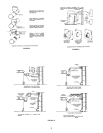
2
FLUE PIPE AND CHIMNEY
The flue pipe should be carefully inspected and replaced if necessary in connection with installation of a draft hood. All
installations must operate with a negative draft overfire. Refer to your local gas company or codes for assistance or to the
furnace and/or boiler manufacturer for recommendations.
The flue pipe entrance into the chimney should be at least two feet (.610m) above the clean-out opening in the chimney.
The chimney should extend high enough above the dwelling or other neighboring obstructions so that wind from any direction
will not strike the chimney from any angle above horizontal. Unless the obstruction is of greater magnitude, it is the usual
experience that a chimney extending two feet above flat roofs or above fire wall parapets, and peaked roofs within 30 feet
(9.144m) will be reasonably free of downdraft.
Where the chimney is unlined or where local experience indicates that flue gas condensate might be a problem, the local gas
company should be consulted.
The chimney should be examined and thoroughly cleaned, if necessary, before installation is made to make sure it freely
conduct the flue gases to the outside.
Flue pipe should extend through the chimney wall to inner face of chimney liner but not beyond, and should be firmly
cemented to masonry. A thimble may be used to facilitate removal of flue pipe for cleaning, in which event the thimble should be
permanently cemented in place with mortar or other fireproof material that will not crack or check the flue pipe or thimble,
whichever is used, should be sealed into the chimney liner.
Flue connections from two or more appliances should not enter opposing or adjacent sides of the chimney at the same level.
Under no circumstances should the flue pipe be connected it to a flue of an open fireplace.
INSPECTION OF HEATING APPLIANCE
A careful inspection of furnace or boiler should be made. If cracked heating sections, leaking soft plugs or any other
condition which might make the unit unsatisfactory for gas conversion is found, proper arrangements should be made for
replacement or repair before proceeding with the burner installation. Cracked heating sections should be replaced.
A neutral pressure point adjuster, similar to the one shown in figure 2 may be installed in the flue pipe between the furnace
and a conventional type CSA draft hood. The neutral pressure point adjustment should be left in the fully open position until
after the burner rating has been established. The material used for flue pipe should be resistant to corrosion.
The necessity for installing a neutral pressure point adjuster as outlined above, may be eliminated by reducing the flue pipe
and draft hood to the sizes shown in the table.
NOTE: For oil fired conversions consult boiler or furnace manufacturer. Appliance must maintain negative draft overfire.
FIGURE 1
Air Inet Opening 1 Sq.
in. (645.2 mm
2
) for each
1,000 Btu (.2931 kW)
per hour input.
Ventilating Air Opening
1 Sq. in. (645.2 mm
2
)
for each 1,000 Btu
(.2931 kW) per hour
input.
Application located in confined spaces. Ventilation air
from inside building - combustion and draft hood
dilution air from outside. Ventilated attic or ventilated
craw space.
NOTE: Ducts used for make-up
air may be connected to the
cold air return of the heat-
ing system only if they connect
directly to outdoor air.
Attic Ventilation Louvers are
required at each end of attic
with alternate air inlet No. 1.
1, 2, and 3 mark alternate loca-
tions for air from outdoors. Free
area shall be not less than 1 Sq.
in. (645.2 mm2) per 5,000 Btu
(.1.465 kW) per hour of the total
per hour of the total input rating
of all appliances in the
enclosure.
Crawl-space Ventilation Louvers
for unheated crawl space
are required with alternate air
inlet No. 3.
Each Ventilation Air Opening
from inside the building shall
have a free area of not less than
1 Sq. in. (645.2 mm2) per 5,000
Btu (.1.465 kW) per hour of the
total per hour of the total input
rating of all appliances in the
enclosure.
Illustration showing air opening necessary to supply air for combustion
when heating appliance is installed in an enclosed room.


















